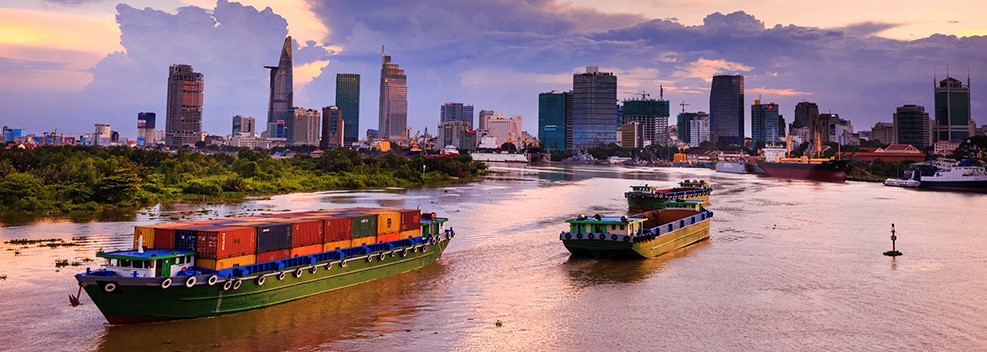
[6 Jan 2020]— Vietnamese businesses should prepare to deal with potential trade barriers that could arise early next year when the historic EU-Việt Nam Free Trade Agreement (EVFTA) takes effect, experts have said.
Phạm Bình An, director of the HCM City International Integration Support Centre, said the EVFTA trade deal was expected to increase Việt Nam’s GDP by 4.3 per cent by 2030, and exports to the EU could surge by about 44 per cent by 2030.
Speaking at a meeting on trade in HCM City, An noted, however, that trade remedies such as anti-dumping, anti-subsidy and safeguard measures could arise on Vietnamese exports.

Exporters should restructure their production and export output to avoid anti-dumping and anti-subsidy investigations, and “should follow product origin rules and trade fraud to avoid lawsuits”, he said.
According to recent data from the Provincial Competitiveness Index Report, only 1.55 per cent of Vietnamese enterprises surveyed had in-depth knowledge of the EVFTA. More than 65 per cent of the surveyed enterprises had only heard of it briefly.
Vũ Xuân Phong, former vice president of Việt Nam International Arbitration Centre (VIAC), said the signing of EVFTA had opened a new era for both Việt Nam and the EU as the country would have access to Europe’s 500 million-strong consumer market.
Việt Nam is among the top 10 exporting countries to the EU. Within ASEAN, Việt Nam is EU’s second biggest trade partner and largest exporter of goods.
“However, most Vietnamese enterprises still do not have a deep understanding of the major free trade agreement,” he said. “This is a worrying sign.”
Nguyễn Thảo Hiền, deputy director of the European-American Market Department under the Ministry of Industry and Trade, said the EU in 2018 was Việt Nam’s second largest export partner, after the US. However, in the first 11 months of 2019 exports reached only US$38.38 billion, a slight drop of 1.26 per cent over the same period last year.
The signing of EVFTA would provide great opportunities for Vietnamese agricultural products, footwear, textiles, computers, plastic products, and seafood.
Other key sectors include automobiles and motorcycles, green growth, intellectual property rights, transportation and logistics.
The elimination of bilateral tariffs and export taxes as well as the reduction of non-tariff barriers affecting cross-border exchanges of goods and services is expected to boost bilateral trade, she said.
However, the EU has set strict criteria for product quality to protect consumers’ health, including high technical standards and regulations on packaging and labeling, she added.
“Vietnamese enterprises must be fully aware of the commitments made by Việt Nam in the trade agreement.”
Recommendations
Hiền, deputy director of the European-American Market Department, said that enterprises must adhere to Rules of Origin (RO), especially as traceability regulations for importing countries have become increasingly strict.
Enterprises should also meet food safety and hygiene standards and management procedures set by the EU, as well as corporate social responsibility and transparency of information on labour and the working environment, she said.
The use of modern methods will ensure strict control of goods’ authenticity, quality and origin, she added.
To enhance competitiveness, Vietnamese manufacturers should also shift to advanced production and processing systems, according to Hiền.
From a legal perspective, Châu Việt Bắc, deputy secretary general of VI-AC, said that commercial arbitration could resolve conflicts between the Government and investors or between enterprises and enterprises in trade deals.
Thanks to a simple and fast process, commercial arbitration has become effective for businesses that encounter problems in signing contracts, while helping facilitate access to the EU market.
Trương Đình Hòe, general secretary of Việt Nam Association of Seafood Exporters and Producers (VASEP), said that enterprises of seafood exports had prepared all the required conditions of the EU to obtain certificate of origin, certificate of food hygiene and safety, and certified environmentally friendly products.
VASEP in 2019 failed to achieve its target of $2 billion worth of exports of seafood to the EU. The association has set the same target for 2020, accounting for 20 per cent of the country’s total seafood export, according to Hoè.
The EVFTA, signed on June 30 in Hà Nội, is one of the most ambitious agreements concluded between the EU and Việt Nam. Over a 10-year period, more than 99 per cent of tariffs on goods from both sides will eventually be removed. — VNS
 German firms see positive outlook in Vietnam (08/12/2019)
German firms see positive outlook in Vietnam (08/12/2019)
 Techfest Vietnam 2019 welcomes start-ups and investors (07/11/2019)
Techfest Vietnam 2019 welcomes start-ups and investors (07/11/2019)
 Campaign to build corporate culture launched (05/10/2019)
Campaign to build corporate culture launched (05/10/2019)
 Việt Nam ranked third most active startup ecosystem in ASEAN (02/09/2019)
Việt Nam ranked third most active startup ecosystem in ASEAN (02/09/2019)
 EVFTA opens door wide for Vietnam’s agricultural produces (02/08/2019)
EVFTA opens door wide for Vietnam’s agricultural produces (02/08/2019)
 EVFTA and challenges for Vietnamese SMEs (04/07/2019)
EVFTA and challenges for Vietnamese SMEs (04/07/2019)
 Businesses key to ensuring environmental protection (07/06/2019)
Businesses key to ensuring environmental protection (07/06/2019)
 Private sector needs more impetus (05/05/2019)
Private sector needs more impetus (05/05/2019)
 Good start for Vietnam Economy in 2019 (07/04/2019)
Good start for Vietnam Economy in 2019 (07/04/2019)
 Women power helps boost Việt Nam’s economy (08/03/2019)
Women power helps boost Việt Nam’s economy (08/03/2019)